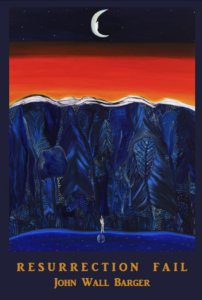by Bret Crowle
Resurrection Fail
by John Wall Barger
Spuyten Duyvil (2021)
Resurrection Fail begins with the disciplined and passionate detailing of personal experiences our author, John Wall Barger, but like a swinging pendulum, readers are thrusted into a surreal exploration of their own human experience. We are taken on a metaphoric journey through existentialism and the consequences of living, all whilst travelling hand-in-hand with Barger.
Readers are transported through an exploration of, not only the author’s world, but also their own. Masterful in craft, the collection is broken into four sections by utilizing four individual pieces titled Resurrection Fail. These pieces act as guiding points and pillars throughout the whole collection – bringing forth and conveying a variety of anecdotal truths.
The author teaches the reader that the surreal and seemingly impossible often twists and melds into the inevitable and anticipatory. Enthusiasm in the examination of the now leaches from the page, but the progression of the collection swings us to a place in which past meets present, as is presented in Resurrection Fail:
Like the anatomy student
I once met
who slid the sheet
off a corpse
and there was
his childhood crush. (76)
Barger’s impeccable ability to fuse word with emotion brings out intricate intimacy, threaded throughout the collection. We are entirely at the mercy of the author as we navigate a plethora of facets of the human experience: loss, death, suicide, pleasure, reconnection. Time and time again, we are reminded that beauty cannot exist without bleeding brutality, as represented in Resurrection Fail:
… so I saw her again
with all her faces at once
like a village,
the villagers walking out
to the night forest
bearing the beloved in their arms
the one who would die that night. (57)
By posing commentary on topics that have the potential to be universally understood, Barger gives readers the opportunity to engage on both a collective and individualized journey. This is perfectly displayed in Resurrection Fail, which prompts the reader to think about the colour of the moon, their knowledge of the moon, and what they believed to be true, all while then connecting this realization back to a time over the barracks of Birkenau:
… Moon
can mean sorrow:
as in, I read how the dark
side of the moon
is actually turquoise
which glows like ice
over the barracks
of Birkenau. (39)
And, perhaps Barger is correct in implying that we, the readers, are filled with only the most falsified calcification of hope, that our gullibility and amateurism is inevitable in living and only found in death. With that, we are left with our final pillar of Resurrection Fail, which opens the collection with a bittersweet and masterful note:
Is it a joke to yoke us
one to another
with love
just to yank us apart,
like parodies of the sacred? (13)

